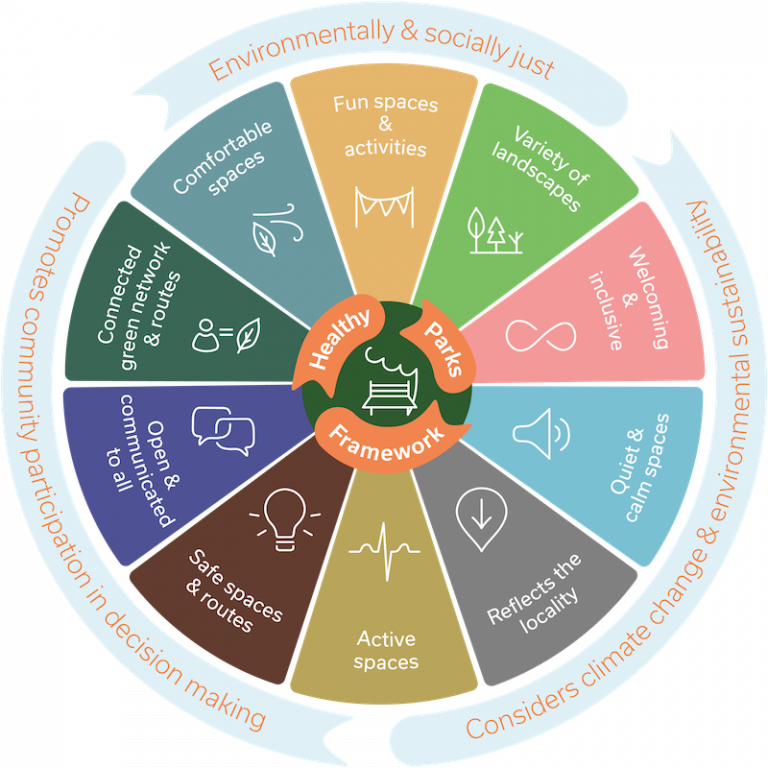Co-Creating a Healthy Parks Framework
8 September 2022
Researchers at UCL along with Camden and Islington Local Authorities have co-created an evidence-based visual framework designed to help park managers and communities plan, manage, and assess their greenspaces to improve the health of residents and tackle health inequalities.

A blog by Liza Griffin, Gemma Moore, Ruth Hynes, Oliver Jones (Head of Greenspace, Camden), Andrew Bedford (Head of Greenspace & Leisure, Islington), Barry Emmerson (Head of Parks, Islington), Andrew Hinchley (Green Space Development Manager, Camden), Marissa Lam, and Meagan Colaiacovo.

Figure 1: The Healthy Parks Framework © 2022 by co-investigators Liza Griffin, Gemma Moore, Ruth Hynes, Camden and Islington Local Authorities is licensed under CC BY-NC-SA 4.0. To view a copy of this license, visit http://creativecommons.org/licenses/by-nc-sa/4.0/. Graphic Design by Alex Harrington Cahuzac.
There are numerous physical and mental health benefits from having quality greenspaces in urban areas. Fifteen years ago, the Department for Environment, Fisheries and Rural Affairs estimated that if everyone had access to sufficient greenspace the benefits associated with increased physical activity alone, could save the health system a staggering £2.1bn per year. Today, parks and open spaces play a more important role than ever before in supporting the mental health of communities in post-COVID recovery towns and cities.
Despite the rich network of parks in North London, not all residents are able to enjoy the benefits of nearby greenspaces. 71% of residents in Islington, and 61% of residents in Camden live in flats that don’t have direct access to any private greenspace. It is perhaps unsurprising then that Camden and Islington Local Authorities face disproportionately acute health challenges. Over 50,000 adults in Camden experience depression and anxiety - 20% higher than the UK average. And currently one in six adults in Islington have diagnosed mental health conditions. In 2013, Camden spent £379 per head per year on mental health, £170 more that the average spend in England.
In order to reap the many advantages of parks and greenspaces, research suggests that we cannot take their health benefits for granted. They need to be appropriately looked after and carefully designed, taking everyone and their needs into account. In the UK, park managers play this crucial role. Camden and Islington Local Authorities (With Oliver Jones and Andrew Hinchley, Camden and Andrew Bedford, Islington) are determined to make the most of their network of greenspaces and in 2019 gained significant funding for their ‘Parks for Health’ programme designed to strategically examine the role that public open spaces have in improving residents’ health and in reducing health inequalities.
Their initial analysis suggested the importance of having a connected web of green infrastructure that would enhance social cohesion, reduce isolation, increase people’s physical health, and improve mental health and wellbeing, while tackling ever increasing health inequalities. However, it soon became apparent that realising these vital ambitions was no easy task.
In 2021, Oliver Jones, head of Camden’s greenspace team, approached urban health researchers Gemma Moore and Liza Griffin at UCL’s Bartlett to help Parks For Health develop a strategic framework for planning, managing, and maintaining their greenspaces with improved health of the public at its heart.
Local Authority partners wanted a visually impactful tool that could be easily applied and that also engaged local communities, encouraging residents who don’t yet use their local parks to participate. Research shows that proximity to greenspace is no straightforward indicator of use. There are numerous reasons why residents don’t feel that they can use their nearby parks: issues of racial and sexual discrimination, feelings of fear, alienation or not belonging, can be compounded with challenges around access, particularly for those living with disabilities, and keep people away.
With all these complexities in mind, the Framework needed to consider a wide range of views and perspectives. Funded through an Impact Acceleration Grant from UCL Public Policy/EPSRC, co-investigators Gemma and Liza organised several co-production workshops with academics and stakeholders from across North London, representing policy and community groups including Parks for London, National Trust, and Public Health England. An extensive evidence-based review of existing frameworks that consider healthy environments was also conducted by researcher Ruth Hynes.
Evidence from these workshops pointed to the qualities of an ideal park that could address the aspirations of good health described above. Healthy parks should be safe and accessible, and have spaces for fun, as well as areas for quiet respite from everyday stresses. Healthy parks must be welcoming social spaces where it’s possible to meet friends, join a group or get active. And healthy parks have good quality environments, that keep us cool in the heat and provide clear air to breathe. They enable people to connect with nature, while also allowing ecosystems, birds, animals, and plants to flourish. Healthy parks should offer a variety of landscapes for diverse purposes, and they should be connected via a network of green infrastructure to preserve ecosystem integrity and allow different people to meet their diverse needs.

Figure 2: Skaters in Camden Park. 'Taken for Camden and Islington’s Parks For Health Project by Vanessa Berberian at Vanessa Berberian Photography. '
The workshop outcomes and evidence review lead to the co-design of the Healthy Parks Framework (see Figure 1). The Framework demonstrates the key characteristics of a health promoting park; provides indicators to assess how far parks currently contribute to the health of communities; and explains possible ‘pathways’ between park characteristics and desired health outcomes – in other words, what can be done in parks to improve people’s health and tackle inequalities?
The Framework is a tool that promotes awareness of the co-benefits of healthy greenspaces amongst policymakers and communities and explains how to plan and design healthy parks. Policy tools of this kind are crucial for not only improving the health of the public and for tackling health disparities, but also for providing quality greenspace that can support crucial ecosystem functions in cities to address the impacts of climate change like flooding and extreme heat.
Research shows that there is a positively reinforcing and symbiotic relationship between quality environments and healthy populations. Reflecting upon these relationships, the Framework also clarifies three guiding values that ought to govern the management and design of parks. Greenspace management that is socially just, participatory in its decision-making and environmentally sustainable can better ensure that principles of health are embedded, and health inequalities are tackled.
The Framework is designed to ensure that boroughs can review and develop their own measurable action plans to improve how their spaces support local communities’ health according to the contexts and specific challenges they face. In sum, the Framework can be used to raise awareness about the relationship between parks and greenspaces and health to public groups and policy makers; assess and maintain existing spaces and facilities, identify what elements of a space and its facilities are significant for public health, plan spaces, activities, and facilities with health in mind; and engage publics and other stakeholders in these processes.
You can watch a short animation about the Framework using this link.
In Summer 2022, Gemma and Liza received a Bartlett Innovation Grant to test the Framework’s operation in North London with park managers, residents, and community organisations. Along with match funding from the Parks for Health Project, this has helped the team produce a series of assets and case studies that support the Framework’s use (with support from researchers Marissa Lam and Meagan Colaiacovo).
The team now plan to engage users beyond Camden and Islington with their ‘innovative Healthy Parks Framework with the potential to change how parks are managed’ (Head of Greenspace, Camden).
 Close
Close

